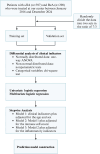Albumin and Gamma-Glutamyl Transferase as Biomarkers for Differentiating Systemic Juvenile Idiopathic Arthritis from Reactive Arthritis
- PMID: 40529895
- PMCID: PMC12170809
- DOI: 10.2147/JIR.S522233
Albumin and Gamma-Glutamyl Transferase as Biomarkers for Differentiating Systemic Juvenile Idiopathic Arthritis from Reactive Arthritis
Abstract
Objective: Systemic juvenile idiopathic arthritis (sJIA) and reactive arthritis (ReA) share overlapping clinical features, posing diagnostic challenges. Early differentiation is critical for treatment decisions but lacks reliable biomarkers. This study aims to identify simple clinical indicators and develop a clinical prediction model to distinguish sJIA from ReA.
Methods: This study retrospectively included clinical data of 397 sJIA patients and 290 ReA patients who attended the Children's Hospital of Chongqing Medical University from 2016-2024. Key predictors were identified by ANOVA, chi-square tests, univariate logistic regression, multivariate logistic regression, and stepwise analysis. The diagnostic model was established and validated by performing ROC analysis. Furthermore, we additionally included data from 20 sJIA and 20 ReA patients from two other centers to validate the above results.
Results: A total of 19 statistically different clinical indicators were identified by ANOVA and chi-square tests. These indicators were included in univariate and multivariate logistic regression analyses, lower albumin levels and significantly higher levels of gamma-glutamyl transferase (GGT) were found in sJIA patients compared to ReA in both the training and validation sets (p values were all < 0.05). In a stepwise analysis of age, gender, inflammatory cells (lymphocytes, monocytes) and inflammatory markers, it was found that albumin and GGT were still effective in differentiating between the two diseases. Clinical prediction models were developed using albumin and GGT, with AUCs of 0.842 (training) and 0.849 (validation), showing excellent diagnostic effect. These indicators also demonstrated good diagnostic efficacy in cohorts from two other centers.
Conclusion: Albumin and GGT are important clinical indicators for differentiating sJIA from ReA. The albumin-GGT prediction model provides a simple, clinically feasible tool to reduce diagnostic uncertainty.
Keywords: albumin; clinical prediction model; gamma-glutamyl transferase; reactive arthritis; systemic juvenile idiopathic arthritis.
© 2025 Li et al.
Conflict of interest statement
The authors declare that the research was conducted in the absence of any commercial or financial relationships that could be construed as a potential conflict of interest.
Figures




Similar articles
-
UBE2D1 as a key biomarker in systemic juvenile idiopathic arthritis: a new perspective on diagnosis and disease activity assessment.Arthritis Res Ther. 2025 Jul 9;27(1):140. doi: 10.1186/s13075-025-03606-8. Arthritis Res Ther. 2025. PMID: 40635084 Free PMC article.
-
Molecular feature-based classification of retroperitoneal liposarcoma: a prospective cohort study.Elife. 2025 May 23;14:RP100887. doi: 10.7554/eLife.100887. Elife. 2025. PMID: 40407808 Free PMC article.
-
Surveillance for Violent Deaths - National Violent Death Reporting System, 50 States, the District of Columbia, and Puerto Rico, 2022.MMWR Surveill Summ. 2025 Jun 12;74(5):1-42. doi: 10.15585/mmwr.ss7405a1. MMWR Surveill Summ. 2025. PMID: 40493548 Free PMC article.
-
Prevalence and odds of anxiety and depression in cutaneous malignant melanoma: a proportional meta-analysis and regression.Br J Dermatol. 2024 Jun 20;191(1):24-35. doi: 10.1093/bjd/ljae011. Br J Dermatol. 2024. PMID: 38197404
-
Assessing the comparative effects of interventions in COPD: a tutorial on network meta-analysis for clinicians.Respir Res. 2024 Dec 21;25(1):438. doi: 10.1186/s12931-024-03056-x. Respir Res. 2024. PMID: 39709425 Free PMC article. Review.
References
-
- Petty RE, Southwood TR, Manners P, et al. International league of associations for rheumatology classification of juvenile idiopathic arthritis: second revision, Edmonton, 2001. J Rheumatol. 2004;31(2):390–392. - PubMed
LinkOut - more resources
Full Text Sources
Miscellaneous

